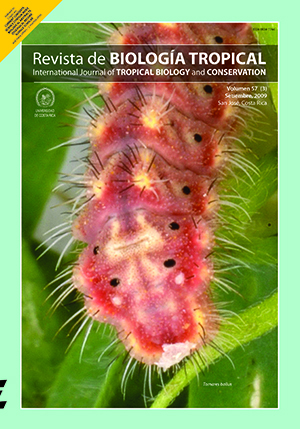Resumen
Predation has been hypothesized to be a strong selective force structuring communities of tropical lizards. Comparisons of perch height and size-based predation frequencies can provide a unique window into understanding how predation might shape habitat selection and morphological patterns in lizards, especially anoles. Here I use plasticine clay models, placed on the trunks of trees and suspended in the canopy to show that predation frequency on clay models differs primarily according to habitat (canopy vs. trunk-ground), but not according to size. These data are discussed in light of observed lizard abundances in the lowland forests of Costa Rica, and are presented as partial explanation for why fewer lizards are found in tree canopies, and more lizards are found on ground-trunk habitats.Comentarios

Esta obra está bajo una licencia internacional Creative Commons Atribución 4.0.
Derechos de autor 2009 Revista de Biología Tropical
Descargas
Los datos de descargas todavía no están disponibles.






